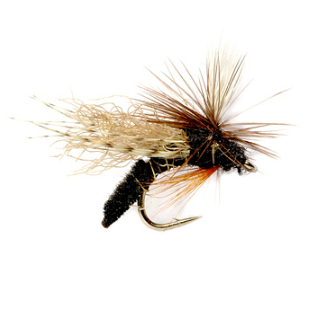Big trout won’t chase adult caddis as much as they will go after emerging caddis that are still in the water.
Tom Rosenbauer doesn’t like caddis flies.
OK. Maybe you need some background.
I’m in snowy Island Park, Idaho, for a couple of days this week to drop in on the School of Trout, a weeklong series of classroom and in-the-field activities for anglers seeking to learn more about the the ways of trout and how to become better anglers. And I’m with a great group of folks.
First, our own Kirk Deeter is here. Deeter, a guide, author and editor of TROUT Magazine, has likely forgotten more about fly fishing for trout than most folks will ever know. He’s joined by Todd Tanner–the planner of this event, and the director of Conservation Hawks, a non-profit group that aims to get sportsmen involved in the climate change policy work. Others include Pat McCabe, Todd’s brother-in-law and fishing guide, Tim Romano, one of the best fly fishing photographers in the business and last, but not least, Rosenbauer of Orvis.
And there are a dozen students here, soaking in the information from these professionals in hopes of putting their new knowledge to work. After morning classes, the students and the instructors retreat to the nearby Henry’s Fork to chase trout. And the fishing has been good, reportedly.
Rosenbauer, on Wednesday night, offered a really detailed presentation with a lot of nuggets of information on trout behavior, insect identification, angling tips and the like.
I watched intently, picking up some real gems from the long-time Orvis employee who knows just about everything there is to know about fly rods, flies, fishing, casting and all the sundry skills that accompany each discipline of the craft. So I was particularly interested when Rosenbauer looked out over the group of a dozen students and said, “The caddis fly is the most dishonest fly. Ever.”
Tim Flagler ties a great caddis emerger pattern. These are the flies we should fish more, Tom Rosenbauer says.
Elaborate, please, Tom.
And he did. Here’s the deal:
Caddis flies, in their adult form, require a lot of effort for a trout to expend with minimal payoff. If you’ve ever seen a prolific caddis hatch, you know that these bugs hatch from the water and then retreat to streamside vegetation, only really returning to the water to lay eggs, by unpredictably bouncing and dancing on the water’s surface.
“Trout will occasionall take adult caddis,” Rosenbauer said. “But they know they’re harder to catch. You’ll see a lot of little fish launching from the water to go after caddis, but, for the most part, big trout don’t bother.”
Anglers get all geeky during caddis hatches, Rosenbauer said. They’ll tie on an elk-hair caddis and then wonder why they’re not catching the bigger trout. As Rosenbauer explains, the effort-to-reward ratio for big trout when it comes to adult caddis simply isn’t worth it.
“They know they’re too hard to catch,” he said.
But big trout will eat caddis in the nymph and emerger forms. When caddis are popping, and still in the pupa stage or just before they “emerge” into adults, big trout will gorge on these flies. They’re stll in the water, just below the surface. They’re vulnerable. They require very little effort.
From the angler’s perpsective, these are the swirls we see just below the surface, not the full-on rises. That’s when trout are feeding on easy prey. And those are the caddis flies, Rosenbaur says, we, as anglers should fish more.
Like I said. Lots of little nuggets. This one got my attention.
— Chris Hunt



